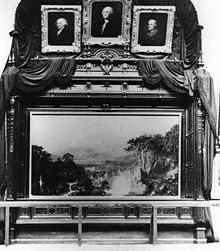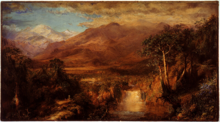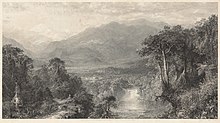Academy Arts Chicago Prints Heart of the Andes Frederic Edwin Church
| The Heart of the Andes | |
|---|---|
 | |
| Artist | Frederic Edwin Church |
| Year | 1859 |
| Medium | Oil on canvas |
| Dimensions | 167.9 cm × 302.9 cm (66.1 in × 119.3 in) |
| Location | Metropolitan Museum of Art |
The Eye of the Andes is a large oil-on-canvas landscape painting past the American creative person Frederic Edwin Church (1826–1900).
At more than v feet (ane.7 metres) high and nigh ten anxiety (3 metres) broad, it depicts an idealized landscape in the Southward American Andes, where Church traveled on two occasions. Its exhibition in 1859 was a sensation, establishing Church as the foremost landscape painter in the United States.[1]
The painting has been in the collection of New York'due south Metropolitan Museum of Art since 1909, and is among Church building'due south virtually renowned works.
Background [edit]

In 1853 and 1857, Church traveled in Republic of ecuador and Colombia, financed by businessman Cyrus Westward Field, who wished to use Church's paintings to lure investors to his South American ventures. Church was inspired by the Prussian naturalist and explorer Alexander von Humboldt, and his 1845 treatise Kosmos. Humboldt was amidst the final of the great scientific generalists, and his fame became similar to that of Albert Einstein a century later.[2] In the 2nd volume of Kosmos, Humboldt described the influence of landscape painting on the study of the natural globe—holding that fine art is among the highest expressions of the dear of nature[three]—and challenging artists to portray the "physiognomy" of the landscape.[2] [4] Church retraced Humboldt's travels in Due south America.
Description and influences [edit]
The Eye of the Andes is a composite of the South American topography observed during his travels. At the heart right of the landscape is a shimmering puddle served by a waterfall. The snow-capped Mountain Chimborazo of Ecuador appears in the distance; the viewer's eye is led to information technology by the darker, closer slopes that pass up from right to left. The evidence of human presence is shown by the lightly worn path, a hamlet and church lying in the key patently, and closer to the foreground, 2 locals are seen before a cross. The church, a trademark item in Church building's paintings, is Cosmic and Spanish-colonial, and seemingly inaccessible from the viewer'southward location. Church building's signature appears cutting into the bawl of the highlighted foreground tree at left. The play of light on his signature has been interpreted as the artist'southward statement of homo'south ability to tame nature—nonetheless the tree appears in poor wellness compared to the brilliant jungle surrounding it.[5]
Church'south landscape conformed to the aesthetic principles of the picturesque, every bit propounded by the British theorist William Gilpin, which began with a conscientious ascertainment of nature enhanced by particular notions nigh composition and harmony. The juxtaposition of smooth and irregular forms was an of import principle, and is represented in The Center of the Andes by the rounded hills and pool of h2o on the one hand, and by the contrasting jagged mountains and crude trees on the other.[half dozen]
The theory of British critic John Ruskin was as well an important influence on Church. Ruskin's Mod Painters was a five-volume treatise on fine art that was, according to American artist Worthington Whittredge, "in every landscape painter'southward hand" by mid-century.[7] Ruskin emphasized the close observation of nature, and he viewed fine art, morality, and the natural world as spiritually unified. Post-obit this theme, the painting displays the landscape in detail at all scales, from the intricate foliage, birds, and butterflies in the foreground to the all-encompassing portrayal of the natural environments studied by Church building. The presence of the cross suggests the peaceful coexistence of organized religion with the mural.[1]
Exhibition [edit]

There is no photographic record of the 1859 exhibition of The Center of the Andes; its exhibition in 1864 is pictured. The overhanging portraits and handrails were added for its inclusion in the fine fine art gallery at New York's Metropolitan Sanitary Fair.
The Heart of the Andes was get-go exhibited publicly between Apr 29 and May 23, 1859 at New York's Tenth Street Studio Edifice, the metropolis's start studio building designed for artists.[eight] Church building had exhibited single paintings previously, such as Niagara (1857), to much success. The event attracted an unprecedented turnout for a single-painting exhibition in the U.s.: more than 12,000 people paid an admission fee of twenty-five cents to view the painting. Even on the final day of the showing, patrons waited in line for hours to enter the Exhibition Room.[viii]
There is no record of the advent or arrangement of the Studio Edifice showroom. It has been widely claimed, although probably falsely, that the room was decorated with palm fronds and that gaslights with silver reflectors were used to illuminate the painting.[8] More than certain is that the painting's casement-window–like "frame" had a breadth of xiv feet and a height of almost thirteen, which further imposed the painting upon the viewer. It was likely made of brown chestnut, a departure from the prevailing gilt frame. The base of the edifice stood on the ground, ensuring that the mural's horizon would be displayed at the viewer'due south center level. Drawn curtains were fitted, creating the sense of a view out a window. A skylight directed at the canvas heightened the perception that the painting was illuminated from inside, as did the nighttime fabrics draped on the studio walls to absorb light. Opera glasses were provided to patrons to permit exam of the mural'due south details, and may accept been necessary to satisfactorily view the painting at all, given the crowding in the exhibition room.[8]
Church's canvas had a stiff consequence on its viewers; a gimmicky witness wrote: "women felt faint. Both men and women succumb[ed] to the dizzying combination of terror and vertigo that they recognize[d] as the sublime. Many of them will later describe a sensation of becoming immersed in, or absorbed by, this painting, whose dimensions, presentation, and bailiwick matter speak of the divine power of nature."[six]
Accompanying the access were 2 pamphlets nearly the painting: Theodore Winthrop's A Companion to The Heart of the Andes and the Reverend Louis Legrand Noble's Church'south Picture, The Center of the Andes. In the style of travel guides, the booklets provided a tour of the painting's varied topography. An excerpt from Noble reads:
Imagine yourself, late in the afternoon with the sun behind you, to be travelling upward the valley along the depository financial institution of a river, at an elevation above the hot country of some v or half dozen thousand feet. At the point to which yous take ascended, heavily-wooded mountains shut in on either hand, (not visible in the picture – only the foot of each jutting into view,) richly clothed with copse and all the appendage of the wood, with the river flowing betwixt them. ... Conspicuous on the reverse side of the river is the road leading into the land above, a wild bridle-path in the brightest sunshine, winding upwardly into, and losing itself in the thick shady woods. The foreground ... forms of itself a scene of unrivalled power and brilliancy, ...[eight]
Church wanted Humboldt, his intellectual mentor, to encounter his masterpiece. Close to the end of the commencement exhibition, on May nine, 1859 he wrote of this desire to American poet Bayard Taylor:
The "Andes" will probably be on its way to Europe before your render to the City ... [The] principal motive in taking the picture to Berlin is to take the satisfaction of placing earlier Humboldt a transcript of the scenery which delighted his eyes sixty years ago—and which he had pronounced to exist the finest in the world.[3]
Humboldt, however, died on May 6 so the planned shipment to Europe did not occur. This disappointed Church, but he would soon meet his future wife Isabel at the New York exhibition.[9] Later in 1859, the painting was exhibited in London (July four – c. Baronial xiv), where it met with like popularity. Returning to New York Urban center, it was exhibited again from October 10 to December 5. In the next few years, showings occurred in Boston, Philadelphia, Baltimore, Cincinnati, Chicago, and St. Louis. An 1864 exhibition at the Metropolitan Sanitary Fair at New York's Matrimony Square is better documented than the original, with photographs extant.
Reproduction [edit]


The 1862 engraving by Charles Twenty-four hour period & Son. 34.four ten 63.2 cm
While the painting was in London, Church's agent arranged to take an engraving of it made by Charles Solar day & Son, which would allow for broad distribution of reproductions and hence more than income. Erstwhile during this period a watercolor copy of The Heart of the Andes was made. It is not sure who painted the copy, only Church very probable is not the artist; the engraver Richard Woodman or ane of his sons has been proposed. The watercolor is now presumed to have originated in Britain and been made for the use of the engraver, William Forrest of Edinburgh. The watercolor is now in the National Gallery of Art, Washington, D.C.[10] [xi]
Reception and legacy [edit]
The painting was widely acclaimed. Poetry was written in its award, and a composer, George William Warren, dedicated a piece to information technology in 1863. Marker Twain described the painting to his brother Orion Clemens in a letter of 1860:[12]
I accept just returned from a visit to the most wonderfully beautiful painting which this city has ever seen—Church building'south 'Heart of the Andes' ... I have seen it several times, only information technology is always a new picture—totally new—you seem to come across zero the second time which you saw the first. We took the opera glass, and examined its beauties minutely, for the naked heart cannot discern the little wayside flowers, and soft shadows and patches of sunshine, and half-subconscious bunches of grass and jets of water which form some of its near enchanting features. There is no slurring of perspective effect almost it—the nigh distant—the minutest object in it has a marked and distinct personality—so that you may count the very leaves on the trees. When you offset meet the tame, ordinary-looking moving-picture show, your first impulse is to turn your back upon it, and say "Humbug"—but your third visit will discover your encephalon gasping and straining with futile efforts to take all the wonder in—and appreciate it in its fulness and empathise how such a miracle could have been conceived and executed past human encephalon and human being hands. You will never get tired of looking at the picture, but your reflections—your efforts to grasp an intelligible Something—you hardly know what—will abound so painful that you volition accept to get away from the thing, in lodge to obtain relief. You may find relief, but you cannot banish the picture—it remains with you lot still. It is in my mind now—and the smallest feature could non be removed without my detecting it.[13]
The New York Times described the painting's "harmony of design" and "chaos of chords or colors gradually rises upon the enchanted mind a rich and orderly creation, full of familiar objects, nevertheless wholly new in its combinations and its significance."[14]
Church eventually sold the work to William Tilden Blodgett for $ten,000—at that time the highest price paid for a work by a living American creative person. Moreover, Church reserved the correct to re-sell the painting should he receive an offer of at to the lowest degree $twenty,000. (American landscapist Albert Bierstadt surpassed both prices when he sold The Rocky Mountains, Lander'due south Peak for $25,000[15] in 1865.) Blodgett held the painting until his death in 1875.[16] It was acquired by Margaret Worcester Dows, widow of grain merchant David Dows, and bequeathed to the Metropolitan Museum of Art upon her decease in Feb 1909.[17] In 1993, the museum held an exhibition that attempted to reproduce the conditions of the 1859 exhibit.
Recent descriptions identify it within modern thematic discourse, including the tension betwixt art and scientific discipline, and American territorial expansion. The split between the humanities and the scientific worldview was nascent in 1859: Charles Darwin's On the Origin of Species was published later in the aforementioned year every bit Church's painting.[iii]
References [edit]
- Notes
- ^ a b Chicken, Wayne (2002). American Art: History and Culture. McGraw-Colina Professional. pp. 207–209. ISBN978-0-07-141524-8.
- ^ a b Gardner, Albert 10 Eyck (Oct 1945). "Scientific Sources of the Total-Length Landscape: 1850". The Metropolitan Museum of Art Bulletin. New Serial. The Metropolitan Museum of Fine art. 4 (2): 59–65. doi:10.2307/3257164. JSTOR 3257164.
- ^ a b c Gould, Stephen Jay. "Church, Humboldt, and Darwin: The Tension and Harmony of Fine art and Science." Latin American Popular Culture: An Introduction. Rowman & Littlefield: 2000. ISBN 0-8420-2711-4; pp. 27–42.
- ^ Büttner, Nils (2006). Landscape Painting: A History. trans. Russell Stockman. New York: Abbeville Press Publishers. pp. 283–285. ISBN978-0-7892-0902-3.
- ^ Sachs, pp. 99–100
- ^ a b Poole, Deborah. "Landscape and the Purple Bailiwick: U.South. Images of the Andes, 1859–1930." Shut Encounters of Empire: Writing the Cultural History of U.Due south.-Latin American Relations. Duke Academy Press: 1998. ISBN 0-8223-2099-1; pp. 107–138.
- ^ Wagner, Virginia L.; Ruskin, John (Summer–Autumn 1988). "John Ruskin and Artistical Geology in America". Winterthur Portfolio. 23 (ii/iii): 151–167. doi:10.1086/496374.
- ^ a b c d e Avery (1986)
- ^ Howat, 88
- ^ Carr, Gerald Fifty. (1982). "American Fine art in Corking United kingdom: The National Gallery Watercolor of 'The Eye of the Andes'". Studies in the History of Art. 12: 81–100. JSTOR 42617951.
- ^ "The Center of the Andes". National Gallery of Art . Retrieved October 12, 2018.
- ^ Twain, Mark (1929). Marking Twain's Letters, Vol. two. Jazzybee Verlag Jurgen Beck. pp. 15–16. ISBN9783849674632.
- ^ Avery (1993), 43–44
- ^ Quoted in Sachs, pp. 99—100
- ^ Huntington, David C. (1966). The Landscapes of Frederic Edwin Church building: Vision of an American Era. George Braziller. p. 88. LCCN 66-16675.
- ^ Howat, 89
- ^ The New York Times, February 3, 1909
- Sources
- Avery, Kevin J. (Winter 1986). "The Heart of the Andes Exhibited: Frederic Eastward. Church building's Window on the Equatorial World". American Art Journal. Kennedy Galleries, Inc. 18 (1): 52–72. doi:10.2307/1594457. JSTOR 1594457.
- Avery, Kevin J. (1993). Church'south Groovy Picture, the Middle of the Andes. New York: Metropolitan Museum of Fine art. ISBN9780810964518.
- Sachs, Aaron (2007). The Humboldt Electric current: A European Explorer and His American Disciples. Oxford Academy Press. ISBN 0-xix-921519-vii
External links [edit]
- The Metropolitan Museum of Fine art offers a zoomable view of the painting and photographs of the installation.
Source: https://en.wikipedia.org/wiki/The_Heart_of_the_Andes
0 Response to "Academy Arts Chicago Prints Heart of the Andes Frederic Edwin Church"
Enregistrer un commentaire